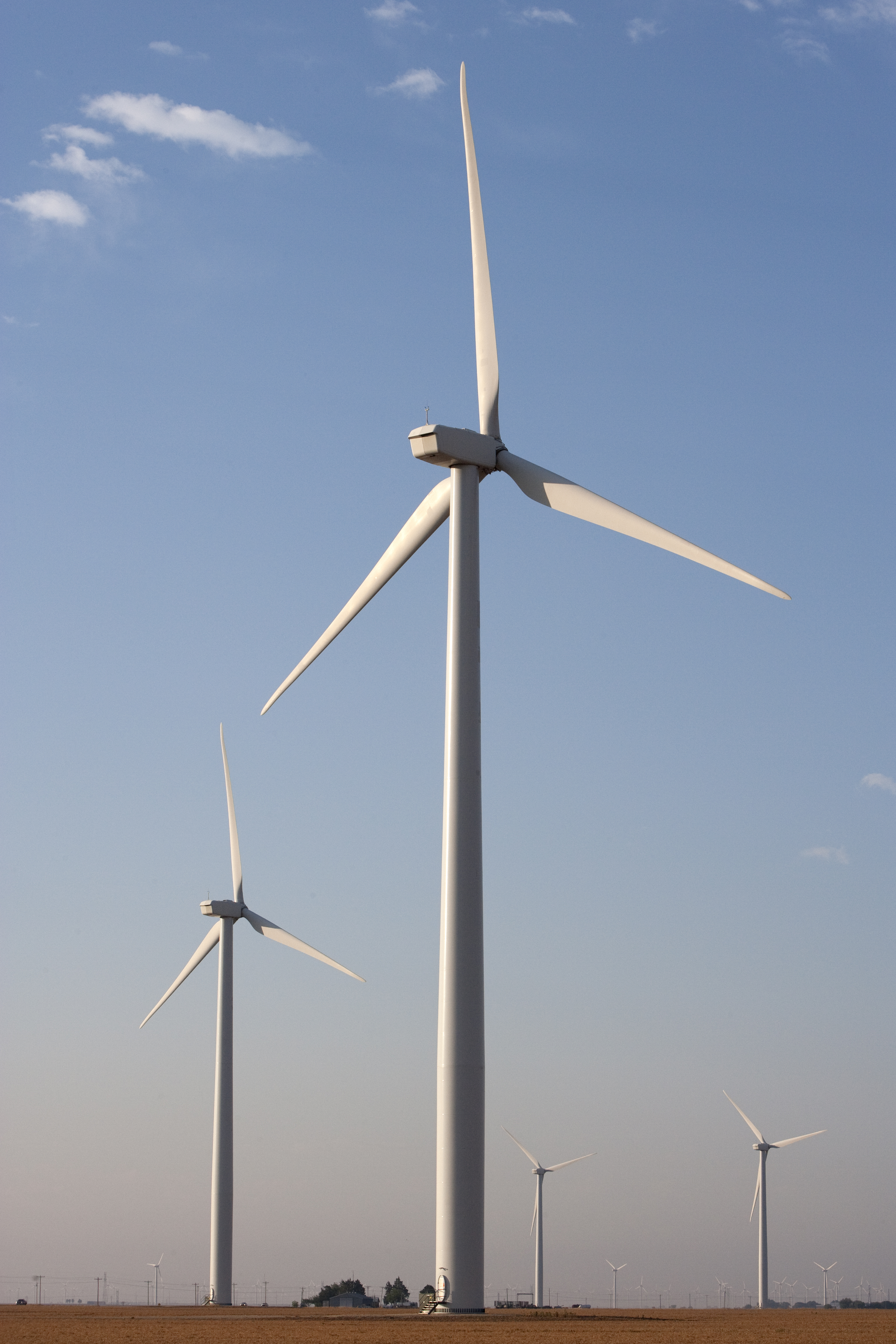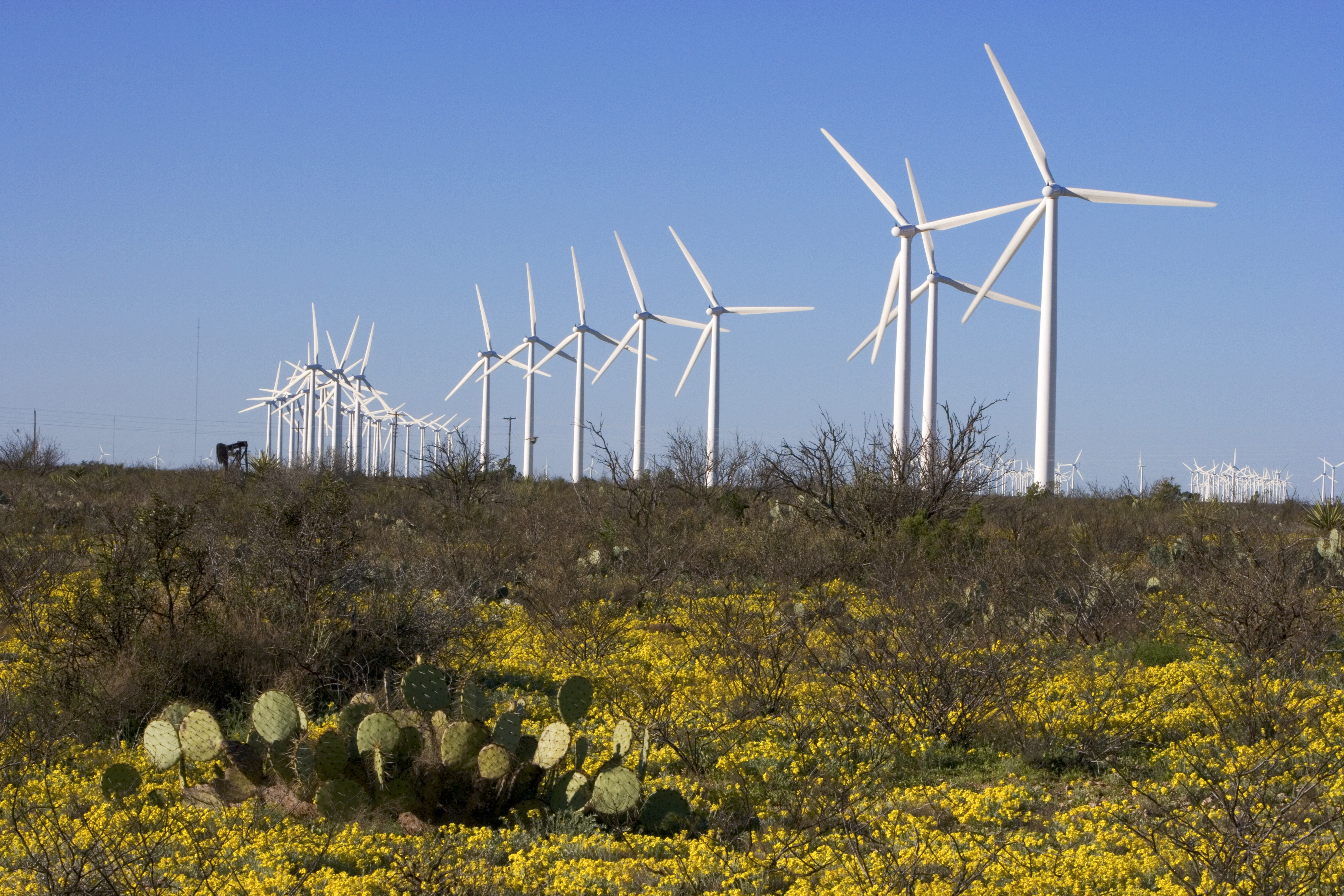What Is Wind?
Wind is the movement of air as a result of the planet revolving while our sun heats uneven surfaces of the earth (such as mountains and valleys). Wind power is a pollution-free, reusable, and multi-use form of energy. Humans have harnessed wind energy in many ways including transportation (sailing ships), recreational activities (paragliding), and generating electricity. Wind turbines, which convert wind into electricity, are becoming more important to our sustainable energy future and have become a recognizable feature in the West Texas landscape as well as the energy landscape of the Lone Star state.
Wind Technologies

What’s the difference between a windmill and a wind turbine? The windmill has been and continues to be a well-used technology. Before wind was used to generate electricity on a large scale, windmills were used to mill grain and/or pump water. Windmills (or wind pumps if they were used for pumping water) have existed in many different designs throughout history. Modern windmills and wind turbines are typically tall, vertical towers with blades affixed to a rotor which are connected at the top by means of a horizontal shaft. On wind turbines, the blades spin a shaft which, in turn, activates a generator that produces energy. “Wind turbines are mounted on a tower to capture the most energy. At 100 feet or more above ground, they can take advantage of faster and less turbulent wind.” The wind turbines of today, besides being specifically designed to generate electricity, are the result of human ingenuities and discoveries in physics, space exploration, and engineering.
they can take advantage of faster and less turbulent wind.” The wind turbines of today, besides being specifically designed to generate electricity, are the result of human ingenuities and discoveries in physics, space exploration, and engineering.
The most recognizable modern wind turbine is the horizontal-axis design. These typically have three blades and are operated with the blades facing into the wind. Smaller turbines, typically below 100 kilowatts, can be used for homes, telecommunications dishes, and, sometimes, in connection with photovoltaic (PV) systems. Larger wind turbines, called utility-scale (or large-scale) turbines, range in size from 100 kilowatts to several megawatts. Larger wind turbines are more cost effective and can be used to create a multi-megawatt source of energy when they are grouped together into wind farms.
Photo: Modern wind turbines also come in the form of vertical-axis wind turbines (VAWTs).
Wind farms can be installed anywhere there is abundant wind, land, and access to transmission lines. Large wind farms can be on land and may have several hundred turbines that cover hundreds of square miles or, with emerging technology, can be located offshore. Offshore wind farms, though more expensive as far as construction and maintenance costs, have the benefit of accessing stronger and steadier winds and having less visual impact. Wind power systems start with a utility-scale wind farm, use transmission lines to conduct the electricity to a distribution system, which then move the energy into homes and businesses, and end when with the energy user who is now using cheap, clean, and renewable energy.
Wind power can also be installed on community and residential scales. Residential scale wind turbines, or micro wind turbines, typically have a capacity of less than 100 kilowatts and can help individuals “generate their own power and cut their energy bills while helping to protect the environment. Unlike utility-scale turbines, small turbines can be suitable for use on properties as small as one acre of land in most areas of the country.” Community wind projects, on the other hand, have capacities up to 20 megawatts and must be approved by a local governing body. These projects can be jointly owned by individuals, schools, electric cooperatives, small business owners, and/or other local entities. While community wind requires stakeholders to “have a significant financial stake in the project beyond just land lease payments and tax revenue,” it also keeps more money in local communities and encourages local energy independence.
Wind Power In Texas
Texas is the leading state in wind power. Despite being a state dominated by a party that in modern mentalities is associated with climate change denial and attempts to thwart renewable energy, Texas wind power breaks the stereotype and, on several windy days, easily exceeds federal goals for electricity generated by wind power.
On Nov 28, 2016, wind energy exceed 15,000 megawatts of instantaneous output and on average supplied approximately 41% of Texas’ electricity needs (AWEA Blog).
Texas has over 10,000 wind turbines (nearly 18,000 megawatts of capacity) and most are ironically located in the same west Texas region that has been the heart of fossil fuel country. Many turbines are located on private lands and provide secondary income for landowners in the form of long term leasing fees.
Unique Texas

While Texas is certainly ahead in utilizing wind energy there are many unique factors that have made the states windy aspirations especially successful:
- Supply - Texas, specifically west Texas, has the gift of abundant and steady winds in a place that is unencumbered by sprawling development.
- Renewable Portfolio Standard – The Renewable Portfolio Standard, enacted by the Texas Legislature and adopted by the Public Utility Commission of Texas (PUCT) in 1999, is a rule that mandates a certain amount of construction and wattage of renewable energy usage. This “ensures that the public benefits of renewable energy, such as wind and solar, continue to be recognized as electricity markets become more competitive. It requires companies that sell electricity to retail customers to support renewable energy generation.” The original goals were 5,000 megawatts (MW) of new renewables installed in Texas by 2015 and 10,000 MW by 2025. Texas easily surpassed these goals and by 2011 had already installed 10,000 MW of generating capacity.
- Independent grid and operator – Texas is the only state with its own power grid. The Texas power grid, called the Electric Reliability Council of Texas (ERCOT), covers three-quarters of the Lone Star state and is run by an agency of the same name. ERCOT can build and manage transmission projects at the behest of Texas lawmakers and regulators without complicated interstate political wrangling, making it uniquely positioned to build large scale transmission projects relatively quickly.
- No rules (sorta) – While rates and transmissions operations are set and managed by state agencies such as the PUCT, there is no regulatory agency, permitting, and/or laws when it comes to wind power. This is partly due to the Lone Star state’s deregulated electricity market. “Texas deregulated its electricity market in 2002, forcing power generators, transmission providers, and electricity retailers to separate. Unlike deregulation in California, which led to a near-collapse of the grid and a series of major blackouts in 2000 and 2001, the policy in Texas has mostly worked as planned, thanks to efficient grid operations and the abundance of transmission lines in the CREZ network.”(MIT Technology Review)
- Competitive Renewable Energy Zones (or CREZ) – CREZ was a large-scale infrastructure investment built under Governor Rick Perry. “In 2005 the Texas Legislature enacted a law requiring Texas to increase the use of renewable energy, primarily wind generation, located in West Texas. The legislation required the Public Utility Commission (PUCT) to designate Competitive Renewable Energy Zones (CREZ) throughout the state and develop a plan to construct necessary transmission capacity to deliver new renewable energy to electric customers in Texas” (WETT History). The $7 billion project, approved in 2005 and completed in 2014, upgraded substations, switches, and terminals and built nearly 3,600 miles of power lines that, in total, have the capability to transmit 18,500 megawatts of wind energy from remote west Texas to populated areas like Austin, San Antonio, and Dallas. Without CREZ, there could be no Texas wind boom.
- Tax incentives – The federal renewable electricity production tax credit (PTC) authorizes a production tax credit of 1.5 cents per kilowatt-hour for wind-power-generated electricity. First established in 1992, renewed, expanded, and adjusted for inflation since then, the tax credit is one facet of what makes wind power a more competitive source of energy.
Challenges to Wind Power
One of the biggest challenges with integrating the power of the wind to our existing grid is infrastructure. As seen in Texas, planning, building, and managing new or updated transmission systems is an expensive, and often complex, endeavor. As transmission lines become longer, more power is lost making it much harder to transmit large loads of electricity over long distances. In Texas, the forward-thinking CREZ system has quickly begun to reach full capacity. “At particularly windy times, some wind farms have ended up being effectively stranded, without a way to get power east to the cities. That happened to [one] wind farms in January, when congestion rose on the transmission lines and it could not export its electricity—even when it offered to pay utilities $22 per megawatt-hour to take it. Having spent billions of dollars on a transmission system, the state is now faced with spending hundreds of millions more to expand it—a demonstration of just how costly and complicated it is to shift from fossil fuels to renewable energy, even where the conditions are optimal.” (MIT Technology Review)
Despite its proven effectiveness at delivering electricity, many still worry about the consistency of wind. Wind power is variable and though it is consistent from year to year, there is variation over shorter time periods. Therefore, it is usually used in conjunction with other electric power supplies to ensure reliability. Despite these worries, wind energy continues to reach new heights in the percentage of power it contributes to the grid.
Future of Wind in Texas
The future of wind power in Texas is, by all accounts, bright. Several large corporations including Amazon, General Motors, Google, and Facebook are investing in Texas wind by funding their very own wind farms. With the wind industry already employing over 24,000 people, it is highly unlikely that these jobs can be threatened without major economic losses to livelihoods, investments, and environmental concerns.
Your elected officials need to know you care about wind energy. Find out who represents you here, and reach out to them!
Image Credits: Al Braden Photography, Thomas Conlon, Iron Man Windmill Co. Ltd, Christian T
